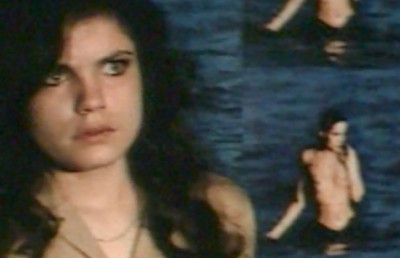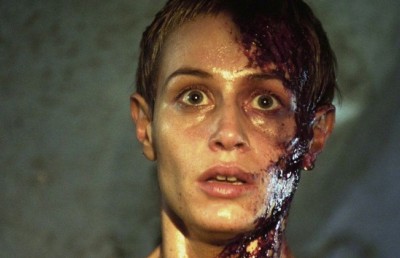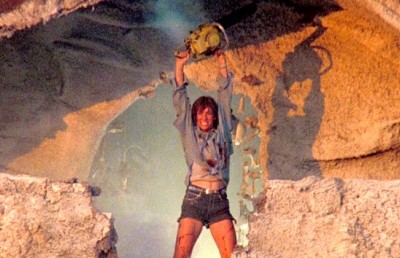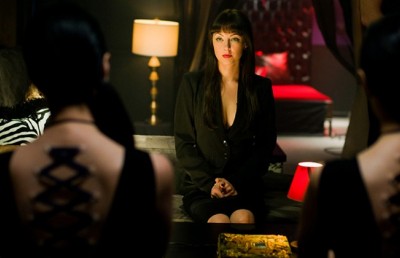Control of the Knife: Transgressing Gender Stereotypes in Bustillo and Maury’s Inside
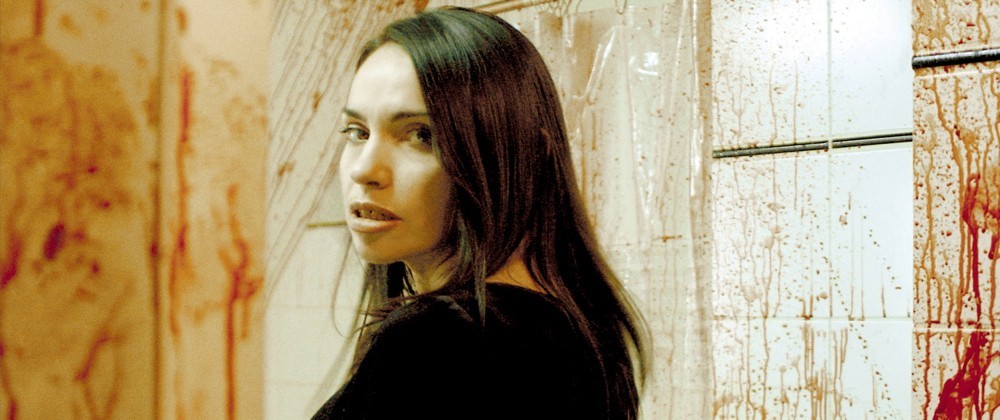
Man endures pain as an undeserved punishment; woman accepts it as a natural heritage. ~Author Unknown
The female victim has been indelibly embedded in cinema since Carl Dreyer’s camera fixated endlessly on Renee Falconetti’s almost unbearably emotive visage in his 1928 masterpiece The Passion of Joan of Arc . Subsequently, similarly inspired images in the medium have become as searingly iconic: Janet Leigh’s frenzied screams reaching a contorted orgasm of fear; or Mia Farrow’s doe-eyed despair as she finally bears witness to her own unseen satanic spawn. A woman’s face has long been the ideal canvas for fear and pain in film, but seldom is she the one inflicting the pain.
The horror genre has always been a minefield for women. Typically a woman’s role is little more than squealing game that a psychopath hunts for meat; occasionally she is the last one standing after enduring hours of psychological and physical ravishment, or, in the rarer cases, she is the killer herself. As one-dimensional as these sexist genre and gender roles commonly are, horror is frequently an arena where women are allotted complicated, three dimensional realization in film. In reality no one is innately good or evil, and these seemingly severe characters get closer to an emotional truth. Though this is rarely presented in a straightforward manner, the complicated nature of the feminine identity is truly allowed to flourish in horror films. The 2007 French film Inside is a razor sharp meditation on not only the depiction of women in horror, but of women in cinema at large. The creative team of Alexandre Bustillo and Julien Maury were adamant in crafting a film that would push the genre to its absolute limits.
The French New Wave of the 1950’s and 1960’s affectionately riffed upon the golden era of Hollywood, but the New French Horror movement of the last ten years has rejected American sensibilities and instead capitalized on the international acclaim and boundary-pushing freedom of the New French Extremity. Both camps present situations of extreme sex and violence imbued with classic art house motifs such as struggles surrounding class or family (Ironically these movements have found much greater success in North America where appetites for more transgressive cinema are considerably more forgiving than in France). Facing criticism of being little more than torture porn in another language, filmmaker Pascal Laugier (of Martyrs fame) defends the Gallic style as “being linked to traditionally American Torture Porn, but that French films are about pain, not torture.” Pornography and horror both aim to stimulate a direct emotional and physical response from the viewer and it is in this cinema of the flesh where we find the most provocative roles for women.
Though these extreme products of the style bear the reactionary and occasionally satirical hallmarks to France’s turbulent political and social climates (the Parisian riots; President Nicolas Sarkozy’s neo-conservative regime), Inside ‘s sweep is more universal. A hybrid of devastating honesty and near-absurdist violence, the film is ultimately a woman’s reaction to societal pressure, to the antiquated patriarchal concept of reproduction being a woman’s chief purpose. Additionally, it shows a woman’s high pain threshold being pushed to dizzying new heights that no man in film could possibly hope to withstand.
The film began its genesis as a standard ‘lone woman hunted by remorseless male’ scenario, but by opting to change the sex of the antagonist, the filmmakers envisioned a dark fairy tale that would have deeper social and sexual implications for both of its leads. Instead of filming yet another sacrificial lamb on the alter of commercial taste, the first-time directors crafted a remarkably violent feminist frenzy that turns Hollywood conventions on their heads, and remains the jewel in the crown of the New French Horror. A decidedly un-studio endeavor, the filmmakers fought tirelessly to protect their bloody baby from the censor’s scissors. Inside contains many dark surprises beneath its brutal veneer of black-blooded horror. And brilliantly, the duo were smart enough to know that in a film about pregnancy, the women cannot be the only characters that bleed.
Commencing with a memorably ghoulish opening, Inside begins with an interior shot of a comfortable fetus within a womb as a distant voice ominously coos “My child. My baby. Finally inside me. No one will take him from me. No one can hurt him now. No one.” Suddenly the child jerks due to a tremendous external cataclysm. The camera reveals the wreckage of a devastating car wreck: a pregnant woman slowly awakens from the accident to see her dead husband beside her. Four months later, we see the survivor, Sarah, finalizing the arrangements with her mother and her mentor for an induced birth on Christmas day. Spending one final night alone and plagued by hideous dreams of childbirth, Sarah is visited by a mysterious woman — credited only as La Femme — who wishes to remove the unborn child from Sarah’s womb. Eventually finding her way into Sarah’s home, La Femme unleashes unparalleled wrath onto Sarah and anyone else who stands in her way of the child. This series of murders is virtually unequalled in its brutality. Once only the two desperate women are left standing, La Femme reveals to Sarah that she was in the other vehicle and lost her own unborn baby to the crash; The Ghost of Christmas Past. A cutaway shot establishes La Femme as the woman speaking the initial dialogue of firm maternal intent.
On paper, the roles could easily be construed as thin archetypes: the angelic victim and the spurned harpy. But through stunning interpretations that only a woman could create, they become complex feminist creations. The filmmakers could only realize their vision through a woman’s performance. It is a common perception for the actress to be viewed as merely the instrument through which a male Svengali may paint his own grisly vision, but Inside blatantly eschews this misogynistic trap with it’s dynamic leads: Sarah and La Femme.
La Femme is such a startling success due in no small part to the formidable actress that portrays her. The notorious Beatrice Dalle was the filmmakers’ only choice to lace into her pinot corset. Dalle’s dominating screen presence and fearsome tabloid image almost overwhelm any role she inhabits. In a making-of documentary for the film, the actress describes her anti method as “You get me. I never play a part. There is me in a new adventure.” Immaculately imposing in head-to-toe black, Dalle’s volatile charisma fashions La Femme into a postmodern angel of death, a haunting spectre of failed motherhood, oozing her own brand of dangerous sexuality. It is her desperate and barbaric — yet tragic — maternal envy blistering through her famous gap-toothed grimace that stokes the relentless carnage.
Female antagonists are a specific breed of character: usually bestowed with proper motivation, they are almost never depicted as ‘simply evil.’ Which poses the question: Is the notion of a female killer distracting for audiences? The answer here is a resounding no. The audience is propelled through an emotional grinder that rivals what the characters themselves endure. The violence on display is so savagely uncompromising it essentially dares the viewer not to look away. Deeply familiar are the moans and aches of the act of murder in film, but actual depictions of penetration of a weapon into flesh remain largely uncommon. To have them delivered by a beautiful woman is one of the film’s most subversive achievements. Here, the audience is immediately confronted with the consequences of violence that are so frequently glazed over so that they may be merely another digestible aspect of our everyday media diet.
It is exceptionally rare that a villain, male or female, be portrayed with a gamut of tangible emotions that render them nearly more sympathetic than the terrorized hero(ine). La Femme has lost her mind to grief. If a woman’s chief role is to reproduce and she is robbed of this then what is she worth? La Femme may have been stripped of her child before she could hold it in her arms, but the cross of postpartum depression hovers nearby. The symbolic intent of her role is heavy with exposition. She is disappointment embodied. Childless, unstable and aggressive, she is everything a modern woman is not supposed to be. This shrewdly toys with the tired device of feminine mental instability, which, at first, may seem like a derogatory continuation of the archetype, but it is ultimately subverting this stereotype into a specifically feminist film language. The obsessive nature of Alex Forrest ( Glen Close in Fatal Attraction ), the allegedly abusive tendencies of Joan Crawford and the feverish jealousy of Hedra Carlson (Jennifer Jason Leigh in Single White Female ) are all present in Dalle’s performance. And this is why La Femme is so frightening; these traits in women are always destroyed, but here they are finally allowed to be victorious without a patronizing moral redemption. There is no man calling the shots; She knows what she wants and is firmly in control.
Allyson Paradis is fiercely impressive in the demanding and deeply unglamorous role of Sarah who finally becomes willing to sacrifice the life of her unborn child rather than let it fall into the frenzied talons of La Femme. Sarah has given up. She has no more tears to shed. Not once in the film does she cry. She is not the miraculous “Final Girl” that film theorist Carol Clover famously described. She is a very real and damaged woman designed to appeal to a female audience. As Paradis says of the film in an interview with Rue Morgue magazine (issue 78): “Girls love gore and horror also, so they need to identify with the main characters too.”
In essentially a two-handed chamber piece where two seemingly opposite women meld and exchange, their specific beings becoming a fractured, yet liberated, whole, suggesting a blood-soaked interpretation of Ingmar Bergman’s minimalist fantasia, Persona . The women commence in the standard survivor and attacker modes, but they share and exchange traits, both becoming equally repellent and endearing — literally dissecting the expectations of feminine behaviour in film. Both are shaped by unfathomable tragedy and reacting in nihilistic ways, Sarah empty and reeling from the death of her beloved fiancé and rejecting her doting family while preparing for the lonely life of a single mother and La Femme, enraged and driven mad by an alternatively forced isolation.
The film shows pregnancy for all of its unspoken terror. Cinema traditionally sentimentalizes childbirth but here we are shown the range of uncertain fear that can await. Visual motifs and tableaus revealing menstruation, stillbirth, miscarriage, and abortion are abundant. There are brief hints of the supernatural, but it is the ferocity of the women’s bare hands that propels the simple narrative at break-neck speed. And the violence always has a purpose. As well as taking the classically French scalpel to bourgeois conventions, the film possesses the traditional framework of Exploitation Cinema, mangling western society’s most cherished talisman: family. Using exaggerated surgical scissors and a potently symbolic knitting needle, La Femme dispenses with a myriad of familial archetypes. By castrating Sarah’s would-be father figure and potential predator (their relationship is ambiguous but a slight gesture from him towards La Femme — then posing as Sarah’s mother — confirms the mature man’s lecherous nature) the film makes its most aggressively emasculating statement. That his death is the most violent in the film is a primal scream in the face of the mainstream father figure.
La Femme, slaying a young gang member begging for his life, shows the wanton waste of youth. A hateful mother aborting a bad egg which had turned to a life of crime. Using a stun gun, La Femme performs a makeshift lobotomy on a handsome young police officer, whose role echoes that of Sarah’s husband. When the officer is later revived in the last gasps of life, he brutally assaults Sarah, supposedly mistaking her for La Femme. La Femme’s vicious intervention is not only to save the long-suffering fetus, but to prevent another brain dead male from committing domestic violence. It’s a blunt sequence but a potent one nonetheless. In one of the most emotionally arresting scenes, Sarah mistakenly kills her perfect mother (Nathalie Roussel, star of beloved French film My Mother’s Castle ) eradicating any chance that this is a fate awaiting either Sarah or La Femme.
Camille Paglia memorably wrote “Menstruation and childbirth are too barbaric for comedy. Their ugliness has produced the giant displacement of women’s historical status as sex object, whose beauty is endlessly discussed and modified. Woman’s beauty is a compromise with her dangerous archetypal allure.” And here, beauty conventions are refreshingly put to task in the film. With surgical precision, the women’s bodies are altered beyond recognition and never once (other than Dalle’s perverse swagger) is there an attempt made to sexualize them. The women reclaim their bodies in a defiant act of anti-sexuality against the grain of commercial expectation. They do not surface at the climax with immaculate hair and makeup. The climactic confrontation between the two warriors makes grimly creative use of kitchen appliances, which are literally used to smash projected expectations of domestic duties in the face.
Sarah, the nightmare Madonna, emerges as a gore Joan of Arc to finally have the upper hand against La Femme’s relentless onslaught only to begin the most arduous delivery in cinema. Helpless and paralyzed in agony, the baby is stuck. What briefly appears as a tender moment of bonding quickly transitions to one of the most grueling sequences in a film ever, as La Femme cuts the struggling child from Sarah’s abdomen. The camera pans along the interior of the house showing the entire narrative in corpses before settling on La Femme disfigured and victorious, cradling the crying infant.
For audiences seeking an experience beyond the artistically bankrupt assembly line of recent American horror, Inside is the uncompromising Grand-Guignol mother of them all. Do we have to turn to the horror genre for feminine characters that are actually progressive? Now that is truly transgressive.



